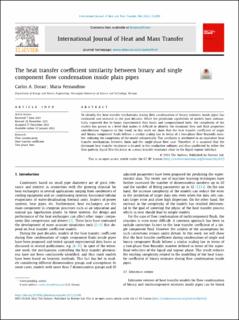| dc.contributor.author | Dorao, Carlos Alberto | |
| dc.contributor.author | Fernandino, Maria | |
| dc.date.accessioned | 2023-03-06T12:54:43Z | |
| dc.date.available | 2023-03-06T12:54:43Z | |
| dc.date.created | 2022-12-14T13:25:57Z | |
| dc.date.issued | 2022 | |
| dc.identifier.citation | International Journal of Heat and Mass Transfer. 2022, 186 . | en_US |
| dc.identifier.issn | 0017-9310 | |
| dc.identifier.uri | https://hdl.handle.net/11250/3056072 | |
| dc.description.abstract | To identify the heat transfer mechanisms during flow condensation of binary mixtures inside pipes has motivated vast research in the past decades. While the prediction capabilities of models have substantially improved due to larger experimental data bases and computational tools, the complexity of the models has grown to a level that makes it difficult to identify the dominant flow and fluid properties contributions. Opposite to this trend, in this work we show that the heat transfer coefficient of single and binary component fluids follows a similar scaling law in terms of a two-phase flow Reynolds number, reducing the complexity of the model substantially. This similarity is attributed to an equivalent heat transfer mechanisms between them and the single-phase flow case. Therefore, it is assumed that the dominant heat transfer resistance is located in the conductive sublayer and thus unaffected by either the flow pattern, liquid film thickness or a mass transfer resistance close to the liquid-vapour interface. | en_US |
| dc.language.iso | eng | en_US |
| dc.publisher | Elsevier Inc. | en_US |
| dc.rights | Navngivelse 4.0 Internasjonal | * |
| dc.rights.uri | http://creativecommons.org/licenses/by/4.0/deed.no | * |
| dc.title | The heat transfer coefficient similarity between binary and single component flow condensation inside plain pipes | en_US |
| dc.title.alternative | The heat transfer coefficient similarity between binary and single component flow condensation inside plain pipes | en_US |
| dc.type | Peer reviewed | en_US |
| dc.type | Journal article | en_US |
| dc.description.version | publishedVersion | en_US |
| dc.source.pagenumber | 10 | en_US |
| dc.source.volume | 186 | en_US |
| dc.source.journal | International Journal of Heat and Mass Transfer | en_US |
| dc.identifier.doi | 10.1016/j.ijheatmasstransfer.2021.122450 | |
| dc.identifier.cristin | 2093127 | |
| dc.relation.project | Norges forskningsråd: 275652 | en_US |
| dc.relation.project | Norges forskningsråd: 259646 | en_US |
| dc.source.articlenumber | 122450 | en_US |
| cristin.ispublished | true | |
| cristin.fulltext | preprint | |
| cristin.qualitycode | 1 | |

